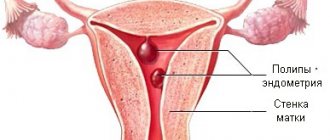One day hospital 3rd KO
Kravchenko
Olga
11 years of experience
Oncologist
Make an appointment
Uterine cancer is a serious pathology that manifests itself in the form of a malignant tumor formed from modified endometrial cells - the inner mucous membrane lining the uterine cavity. This is one of the most common cancers developing in women. The most dangerous period for the development of a tumor is the interval between 65 and 70 years; in general, the incidence increases during menopause, i.e. after 50 years.
Kinds
In accordance with histological characteristics, uterine cancer is divided into the following forms:
- adenocarcinoma, which is the most common type;
- squamous cell form - the least aggressive, successfully treatable;
- glandular-squamous, formed from glandular cells of the endometrium;
- leiomyosarcoma, developing from cells of the muscle layer;
- clear cell, a rather rare form, accounting for 1-5% of all cases;
- mucinous, which is characterized by increased mucus formation;
- serous, in which a tumor with a multi-chamber structure and the secretion of serous fluid is formed.
How does endometrial cancer develop?
Cancer begins with the appearance in the body of just one mutated - altered cell that differs from normal ones. It occurs due to exposure to various substances, including certain medications, diseases, hereditary characteristics and other factors. Most of these cells are identified and destroyed by the immune system, but some still manage to hide from the attention of our natural defenses or resist it. Over time, those that managed to survive create many copies of themselves and form a tumor that can grow into surrounding tissues. In addition, they have another dangerous property - unlike regular cells, which are born, work and die in a strictly defined place, cancer cells can move throughout the body. They enter the circulatory or lymphatic system. The lymphatic system complements the cardiovascular system. The lymph circulating in it - intercellular fluid - washes all the cells of the body and delivers necessary substances to them and takes away waste. In the lymph nodes, which act as “filters,” dangerous substances are neutralized and removed from the body. systems, with their help they spread to various organs, become established in them and create metastases - additional neoplasms.
How does cancer develop in the uterus?
The uterus is an organ similar in size and shape to an average pear in which the fetus grows and develops during pregnancy. It consists of 2 areas:
- the upper part is called the body;
- and the lower one, connecting to the vagina, is the cervix.
The body of the uterus has 3 main layers:
- Internal - endometrium
. During pregnancy, it thickens and nourishes the embryo, and in its absence, the mucous membrane separates and leaves the body approximately once a month. Such cycles are repeated until the onset of menopause - the cessation of menstruation at approximately the age of 49-52 years. - Middle - myometrium
, consisting of the muscles necessary to push the baby out during childbirth. - External - serous membrane
covering the organ from the outside.
Most life-threatening tumors of the uterine body develop in the endometrium. The most common type is adenocarcinoma
, which arise in glandular cells that secrete various substances.
Sarcomas are much less common
starting in the myometrium - the muscle layer, or connective tissue that supports the organ.
Symptoms
It is important not to miss the first signs of uterine cancer and visit a gynecologist on time. A cause for concern should be copious watery discharge, which is periodically mixed with a small amount of blood. Over time, the discharge intensifies and develops into bleeding. In general, any vaginal discharge during menopause may be a symptom of uterine cancer. Signs of endometrial cancer in women of reproductive age are bleeding between periods and heavier than usual menstruation, often accompanied by pain. In addition, general symptoms of cancer appear:
- feeling of constant fatigue, weakness;
- lack of appetite, sudden weight loss;
- anemia, pale skin;
- nausea, malaise;
- with tumor growth – pain in the pelvis or back.
The appearance of uncharacteristic discharge, especially bloody ones, should be a good reason for a visit to the gynecologist.
Causes and risk factors
It is still not known exactly how the malignant process starts, however, the factors that increase the likelihood of uterine cancer have been studied quite well. The most significant of them:
- disturbances in the production of hormones, primarily an increase in estrogen levels;
- obesity, diabetes, hypertension;
- benign neoplasms of the uterus – endometrial hyperplasia, polyps, fibroids;
- too early or late start and end of menstruation;
- no history of childbirth;
- long-term hormonal therapy;
- hereditary predisposition;
- chemoradiation treatment of tumors in other organs;
- lack of regular sexual intercourse for a long time.
The presence of one or more of the listed signs does not mean that a woman will necessarily develop symptoms of a uterine tumor. However, those who are at risk should visit a gynecologist at least once a year to monitor the condition of the reproductive organs.
Prevention
The following recommendations from doctors can prevent the development of uterine cancer:
- Provide rational and balanced nutrition. A large amount of fat in food increases the risk of developing obesity. It leads to hormonal imbalance, which increases the risk of developing uterine tumors. It is necessary to include in the diet foods rich in vitamins and minerals, as well as antioxidants;
- Provide quality regular sex;
- Carry out reproductive function. Women who have not given birth are at high risk of being diagnosed with uterine cancer. This also applies to women who give birth late (after 30 years of age).
The essence of secondary preventive measures is the timely detection and treatment of inflammatory diseases and precancerous conditions. Every woman over forty years of age should regularly visit a gynecologist for a screening examination using transvaginal ultrasound. Thanks to this procedure, uterine cancer can be detected at the earliest stages of development, the effectiveness of treatment of which has the most favorable prognosis. Diagnosed precancerous conditions are also subject to mandatory therapy. Following these recommendations helps reduce the risk of developing uterine cancer.
Stages
The development of a tumor is preceded by the so-called zero stage, when malignant cells are located on a microscopic area of the mucous membrane. According to the degree of growth of the malignant neoplasm, four stages of endometrial cancer are distinguished.
- The process has spread to the entire endometrium, but has not yet affected other layers of the uterine wall. The lymph nodes are not affected, there are no metastases.
- Malignant cells invade the muscle layer and can spread to the cervix.
- All layers of the uterine wall are affected, the malignant process spreads to the vaginal vault and affects regional lymph nodes.
- The tumor has spread to neighboring organs - intestines, bladder, etc. Lymph nodes are affected, metastases have spread to distant organs - lungs, liver, bone structures.
Statistics
According to statistical data, the incidence of this type of cancer is decreasing from year to year.
In the European list of common female cancers, cervical cancer is in 7th place, in Russia it is in 5th place. In the world, this disease ranks fourth among female cancers. In 2021, experts estimate that 570,000 new cases will account for 6.6% of all cancer cases among women. Approximately 90% of deaths from cervical cancer occurred in low- and middle-income countries.
In countries with developed economies, due to early screening and vaccination against human papillomavirus, the incidence rate is lower - approximately 3.8%. In the US, it has decreased by 45% since 1980. In Eastern European countries, incidence rates are higher. At the beginning of the 21st century, there was a slight increase in the percentage of patients who were diagnosed with stage IV malignant lesions of the cervix - from 37.1 to 47.3.
At the age of 30–35 years, the disease is quite rare. The risk group is women from 35 to 55 years old. Only in 20% of cases, women over 65 are diagnosed with cervical cancer. Treatment and survival prognosis depend on timely visits to the doctor and early detection of the disease.
If cancer is detected early, 92% of patients live 5 years or more.
Diagnostics
For uterine endometrial cancer, the symptoms and signs of the disease are not specific. Therefore, instrumental and laboratory studies are of utmost importance for diagnosing a tumor.
- Transvaginal ultrasound. Allows you to describe the structure of the endometrium and control its thickness.
- Hysteroscopy. The procedure for examining the internal cavity of the uterus using a special optical system. During the examination, a biopsy of pathologically altered tissues may be performed.
- Biopsy. An aspiration biopsy is a procedure to remove a sample of the endometrium using a thin, hollow needle.
- Histological analysis of the biopsy specimen. Microscopic examination of the prepared sample is necessary to confirm the diagnosis and to determine the type of malignant cells.
- MRI of the uterus. As a rule, it is carried out at the third or fourth stage of tumor growth to identify the extent of spread, affected lymph nodes and neighboring organs.
Attention!
You can receive free medical care at JSC “Medicine” (clinic of Academician Roitberg) under the program of State guarantees of compulsory medical insurance (Compulsory health insurance) and high-tech medical care.
To find out more, please call +7, or you can read more details here...
Treatment
To successfully treat endometrial cancer, different methods are used, which are selected based on the prevalence of the cancer process, the type of tumor, its location and structure.
- Extirpation of the uterus. During the operation, as a rule, the uterus and fallopian tubes are completely removed, especially if we are talking about a woman who already has at least one child. If the tumor size is small, the cervix is preserved to reduce the risk of complications during the recovery period. At the fourth stage, surgical treatment is not performed.
- Radiation therapy. Treatment is carried out before surgery to reduce the size of the malignant tumor, and also after surgery to prevent relapse due to remaining tumor cells. At the inoperable stage, radiation is used to prolong the patient's life.
- Chemotherapy. Often, cytostatic drugs are prescribed in combination with radiation treatment before or after surgery, as a palliative in inoperable cases and in case of relapse of the disease.
- Hormonal method. Effective for the treatment of hormone-dependent tumors, it is used mainly for the treatment of young patients with a highly differentiated type of cancer.
Metastasis
The spread of metastases in uterine cancer occurs in the following ways:
- Lymphogenic (through lymphatic vessels);
- Hematogenous (with blood flow);
- Implantation (in the abdominal cavity).
First of all, lymphogenous spread of tumor cells occurs.
In this case, regional lymph nodes are affected. Metastases in the lymph nodes are characteristic of late stages of the tumor process. As the oncological focus develops, cancer cells are transferred to individual lymph nodes. When uterine carcinoma begins to increase in size and affects the blood vessels, hematogenous spread of metastases occurs. First of all, other pelvic organs are affected, and then the lungs and bones. Detection of uterine metastases in the liver and kidneys is extremely rare.
The implantation method of metastasis worsens the prognosis of the disease. The appearance of metastases in the abdominal cavity occurs due to the connection of the uterus with the peritoneum through the fallopian tubes. Detection of metastases is carried out using instrumental research. For this use:
- CT, MRI. Tomography makes it possible to establish the localization, size, degree of spread of the cancer process to surrounding tissues, as well as the presence and location of metastatic foci;
- PET-CT. The use of a radioisotope contrast agent makes it possible to most accurately determine the location of metastases. The injected contrast accumulates in pathological foci; a series of layer-by-layer images makes it possible to determine the location and number of metastatic tumors.
Diagnosis and treatment of uterine cancer in Moscow
If you have discovered signs of uterine cancer, contact the Medicina clinic to be examined using modern high-precision diagnostic equipment. Consultations regarding diagnosis, and if the diagnosis is confirmed, qualified treatment is carried out by oncologists-gynecologists of the highest category according to protocols used by leading clinics in the world. Our patients have our own laboratory, which performs all types of tests, and a comfortable hospital with attentive, professionally trained staff.
Questions and answers
How long do they live with uterine cancer?
The lifespan of a woman after detection of a uterine tumor directly depends on what stage of development the disease is at. After surgery performed at an early stage, the patient can live safely for decades. Patients with stage 4 without medical care can die within a few months, and with quality treatment they can live for more than five years.
What does uterine cancer look like?
It is impossible to independently detect a cancerous tumor of the uterus. A full diagnosis is required in a specialized medical institution to confirm or refute the suspicion of uterine cancer.
How does uterine cancer manifest?
The main symptom of a uterine tumor is bleeding from the vagina, which appears between periods and even during menopause. If any bleeding occurs during these periods, you should immediately consult a gynecologist. The earlier a tumor is detected, the higher the chances of a complete cure.
Attention! You can cure this disease for free and receive medical care at JSC "Medicine" (clinic of Academician Roitberg) under the State Guarantees program of Compulsory Medical Insurance (Compulsory Medical Insurance) and High-Tech Medical Care. To find out more details, please call or visit the VMP page for compulsory medical insurance
Forecast
The prognosis for survival from uterine cancer, as well as complete recovery and relapses, depends on many factors. First of all, this is the time of cancer detection; the earlier the tumor is diagnosed, the more favorable the prognosis. The type of malignancy, the patient’s age, the presence of concomitant diagnoses, the chosen treatment tactics and the body’s response to therapy also influence.
Average prognosis for five-year survival if cancer is detected at the appropriate stage:
- in situ – 90%;
- I – 75%;
- II – 69%;
- III (A, B, C) – 58%, 50%, 47%;
- IV (A, B) – 17%; 15%.
Recurrence of uterine cancer is possible, most often it occurs within 2 years after treatment. The relapse rate is on average about 10%, it depends on the type of tumor and the degree of differentiation.







